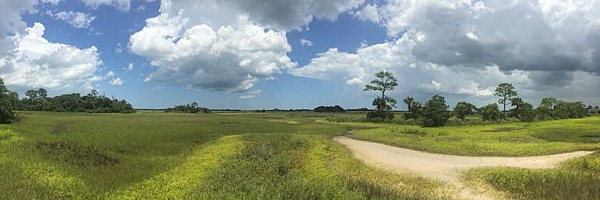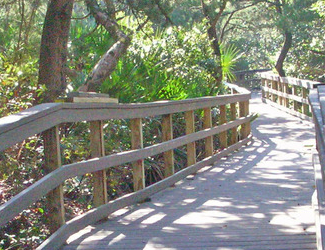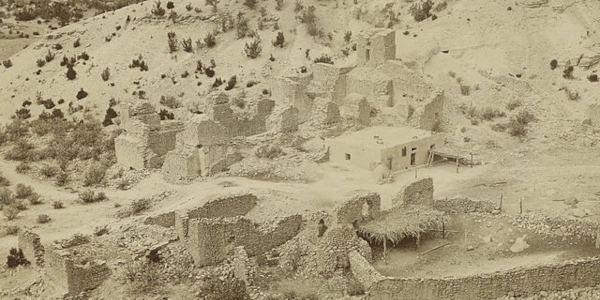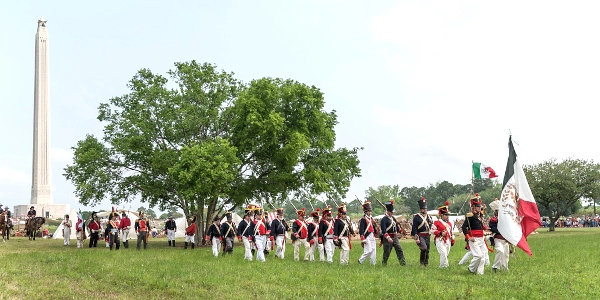
Image above: Flag in front of the Castillo de San Marcos. Courtesy National Park Service.
Spotlight on Lesser Known History
Forts of St. Augustine, Florida
America's Best History Spotlight
On this page we're going to Spotlight the lesser known historic sites and attractions that dot the history landscape across the USA and are worth a visit if you're in their area. And while they may be lesser known, some are very unique, and will be that rare find. You'll be, at times, on the ground floor, or maybe even know something others don't. It'll be fun. Visit them.

Forts of St. Augustine, Florida
Today, when you discuss the forts built to protect St. Augustine during the Spanish period, most focus on the two large and wonderful National Monuments at the Castillo de San Marcos and Fort Matanzas. And while they certainly have their charms and historic importance through the many years of protecting the town from those wandering and aggressive to control North America British, perhaps even more important than those two forts themselves, is the third, Fort Mose, which became the first free black settlement in the United States in 1738. Talk about something most people don't know about. So while it may not be the fort in St. Augustine that you will be taking lots of pictures of (the fort itself no longer exists while the other two do), the state park that recounts its history is just as big a must if you're in town. So St. Augustine is not only the first permanent settlement in the United States, built by the Spanish in 1565, but includes black history aplenty of the free kind just two miles north. Image above: Fort Matanzas, C.E. Peterson, Historic American Buildings Survey. Courtesy Library of Congress.
Sponsor this page for $100 per year. Your banner or text ad can fill the space above.
Click here to Sponsor the page and how to reserve your ad.
Info, What's There Now, History Nearby

Forts of St. Augustine, Florida
There had always been a need to fortify the first permanent European settlement that would actually last in the confines of what is today the continental United States. Since 1565, the Spanish were in constant danger of attack from indigenous sources, plus the English and French who wanted to establish themselves as the dominant power in Florida. The first fort, a wooden structure, was insufficient. It was replaced by the masonry star fort Castillo de San Marcos in 1672. But an attack on St. Augustine, a thirty-nine day siege in 1702, convinced the authorites that their approaches from the north and south were vulnerable. Thus, the two forts, first Fort Mose, established on a settlement of free blacks and legally certified upon the fort's construction in 1738, then Fort Matanzas in 1740, were built to shore up the town's defenses.
What remains of those forts? Both the Castillo de San Marcos, the largest, and Fort Matanzas, are fully restored and can be visited. Fort Mose, now a State Park, is no longer there, but a Visitor Center, exhibits, and walking paths through Florida marshes can get you a good way toward understanding the significance of the first free black settlement in the United States.
With all three, they tell a great story of how St. Augustine, during the Spanish period in particular, shaped how Florida would become what it is today.
Image above: Acreage of marshland on site of first free black settlement at Fort Mose, 2015, Justin Water. Courtesy Wikipedia Commons CC4.0. Below: Castillo de San Marcos, named Fort Marion at the time, 1894, William Henry Jackson. Courtesy Library of Congress.

Where Is It
The three forts are situated surrounding the town of St. Augustine, with the Castillo de San Marcos within the historic district at 11 South Castillo Drive, Saint Augustine, FL 32084. Fort Mose State Park where the history and archaeological remains of the fort are located is located at 15 Fort Mose Trail, St. Augustine FL 32084, which is two miles north of town. Fort Matanzas is located at 8635 A1A South, Saint Augustine, FL 32080, fourteen miles south of town.
Minute Walk in History
Castillo de San Marcos
First is a three part series on the spectacular oldest town in the USA, St. Augustine, we start at the pinnacle fort that overlooks and, at times, protected the town, Castillo de San Marcos. Take a walk with us through its ramparts, listen to living history interpreters discuss its successes and failures, and think back to a time you might have been stationed there, or been in the town below wondering if the fort would hold back its attackers. Music courtesy of Steve Owens.
What is There Now
Castillo de San Marcos National Monument is located on eighteen acres within the historic district of St. Augustine. Its casements include museum exhibits. There is a shot furnace, power magazine, British room, chapel, the Plaza de Armas, and more.
Fort Mose State Park contains forty acres of salt marsh, a visitor center and interactive museum that tells the story of the first free black settlement, plus the remains of the fort in a grove of trees on the site. There are picnic facilities, a boardwalk, and kayak launch.
Fort Matanzas National Monument. A Visitor Center with exhibits and orientation is located on the mainland, which also contains beaches, a nature trail and several boardwalks through natural areas, and picnic area on three hundred acres. Fort Matanzas itself is located across the Matanzas River on Rattlesnake Island.
When Open and How Much
Castillo de San Marcos - Open year round Wednesday to Sunday, except major holidays. Fee for adults over fifteen years of age is $15.
Fort Mose State Park - The park itself is open three hundred and sixty-five days per year. Check with the park for current visitor center hours. Free to visit.
Fort Matanzas - The fort is accessible only by free thirty-six passenger ferry service from the Visitor Center area. Boarding passes must be gotten at the Fort Matanzas Visitor Center. They are issued on a first come first served basis. Check with the park for current hours before making your visit there.
Fees subject to change.
Websites
Castillo de San Marcos
Fort Matanzas
Fort Mose State Park
History Nearby
It's St. Augustine, the first permanent settlement in the United States, so you're surrounded by historic sites to see from the Spanish period three hundred years ago to more recent pursuits, like the World Golf Hall of Fame, or just a walk on one beach after another. Not far up the coast there's the Timucuan National Preserve, and a bit south, the Canaveral National Seashore and its space cousin, Cape Canaveral.
Buy Chronology

Great Book for the History Fan with Fifty Short Essays Telling the Story of American History.
Photos, History, and More Spotlights

Castillo de San Marcos
The Spanish had been settled in St. Augustine since 1565 when Don Pedro de Menéndez de Avilés, the Spanish admiral, founded the military outpost and town that would provide a base for its catholic missions. Although those first one hundred years had not been easy or without conflict, by 1672, they were convinced, including Governor Manuel Cendoya, that they needed a large fortress to defend themselves, better than the dilapidated old wooden fort of the same name. What had convinced them? A pirate attack in 1668 and the British establishment of Charleston in their colony of South Carolina. On October 2, 1672, the new masonry star fort of the Castillo de San Marcos would start construction just north of the old fort. It would be completed in 1695. Today the site is a National Monument which gets over six hundred thousand visitors most years.
So how well did it defend the town? During a two month siege against St. Augustine the British during Queen Anne's War, November 1702, fifteen hundred residents and soldiers took refuge in the fort. The fort withstood the siege with the British abandoning their effort when a Spanish relief fleet from Havana arrived with reinforcements.
The fort was renamed Fort Marion after the United States took possession, but its original name was restored in 1942.
Photo above: Castillo de San Marcos, St. Augustine, Florida.

Fort Mose and the First Black Settlement
In 1738, the Spanish colonial governor of Florida, Manuel de Montiano, chartered the settlement several miles north of town, known then as Gracia Real de Santa Terese de Mose, now as Fort Mose. It would be the first free black settlement legally established in the United States, allowing freed or runaway slaves from the English colonies in the Carolinas a home in exchange for allegiance to the Spanish King, conversion to Catholicism, service for four years in the colonial militia, and assistance in building the second of three forts to defend St. Augustine. That fort would protect the northern approach.
The policy of the Spanish to provide haven for free blacks in Florida had stemmed back to 1689, with King Charles II even issuing a Royal Decree to that effect in 1693. The settlement had begun before the fort as the free black men and women assimilited with the indigenous communities. As such, they also became the first line of defense against attacks against the Spanish by the British. Francisco Menéndez, a free black after his escape from the colony of Carolina, had been, since 1726, the head of the free black militia in St. Augustine and de factor leader of the Mose community.
In 1739, the War of Jenkin's Ear broke out with Georgia Governor James Oglethorpe sending John Palmer with a group of militia, plus Indian and black allies, in June 1740 to take St. Augustine. They would be assisted by seven ships of the British Navy. Manuel de Montiano entrenched his position with six hundred troops, but quickly lost Fort Mose to the British force. On June 15, Montiano, leading the free blacks and Indian allies, and Captain Antonio Salgado leading three hundred Spanish soldiers, counterattacked and retook the fort. Fort Mose was destroyed during the siege, causing the people of the free black settlement to move to St. Augustine itself until the Spanish rebuilt the fort in 1752.
Fort Mose was a small settlement with a timber wall, twenty dwellings and a church inside, plus an earthen fort. It had an estimated population of one hundred. There are no remaining buildings or structures from that time, or the fort either (an archeological dig in 1986 uncovered its location), at the State Park. The community was abandoned altogether after the British gained control of Florida in 1763 after the French and Indian War (Seven Years War), with the Spanish and most black residents of Mose moving to Cuba. The site is listed as a National Historic Landmark as of October 12, 1994, and on the National Register of Historic Places.
Photo above: Grove of trees where site of Fort Mose was located at Fort Mose Historic State Park, 2008, Ebyabe. Courtesy Wikipedia Commons CC3.0.

Fort Matanzas
Built to protect Matanzas Inlet, an important water route south of St. Augustine which could allow attackers access to the rear of the city and out of the range of the defense of Castillo de San Marcos, Fort Matanzas was constructed between 1740 and 1742 in response to Oglethorpe's 1740 attack. On July 21, 1741, prior to its completion, two British ships, the St. Philip and an additional schooner, attacked Spanish vessels near Fort Matanzas. The next day, they attacked again, forcing a Spanish sloop to be grounded, only to be driven off by a Spanish galliot which prevented the British from halting construction of Fort Matanzas.
The British under James Oglethorpe returned in 1742 with twelve ships, but were rebuffed when cannon from Fort Matanzas drove them away. This was the only time that the fort engaged an enemy.
Minute Walk in History
Fort Matanzas
Take a boat ride, walk, climb, and more around Fort Matanzas, the small fort south of St. Augustine, that when built stopped the British from attacking the city, despite its small size. Listen to the pirate National Park Service ranger give a spectacular story about the fort and much else. He's awesome!!
Fort Matanzas was restored in 1916 with its visitor center opening in 1936. Including the nature area on the mainland and Rattlesnake Island, the park has approximately three hundred acres.
Photo above: Boardwalk along the Fort Matanzas nature trail. Courtesy National Park Service.

T-Shirts and Gifts from the official souvenirs of Americasbesthistory.com.
About
America's Best History where we take a look at the timeline of American History and the historic sites and national parks that hold that history within their lands.
Photos courtesy of the Library of Congress, National Archives, National Park Service, americasbesthistory.com and its licensors.
- Contact Us
- About
- © 2024 Americasbesthistory.com.
Template by w3layouts.


